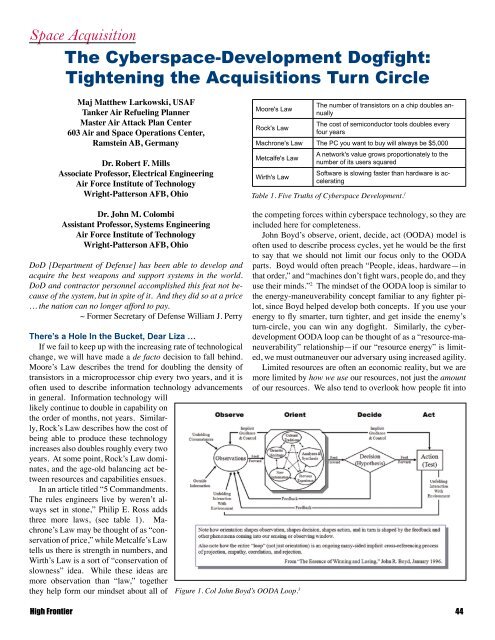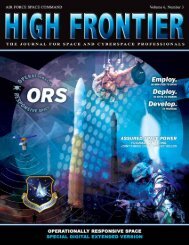Space Acquisition - Air Force Space Command
Space Acquisition - Air Force Space Command
Space Acquisition - Air Force Space Command
You also want an ePaper? Increase the reach of your titles
YUMPU automatically turns print PDFs into web optimized ePapers that Google loves.
<strong>Space</strong> <strong>Acquisition</strong><br />
The Cyberspace-Development Dogfight:<br />
Tightening the <strong>Acquisition</strong>s Turn Circle<br />
Maj Matthew Larkowski, USAF<br />
Tanker <strong>Air</strong> Refueling Planner<br />
Master <strong>Air</strong> Attack Plan Center<br />
603 <strong>Air</strong> and <strong>Space</strong> Operations Center,<br />
Ramstein AB, Germany<br />
Dr. Robert F. Mills<br />
Associate Professor, Electrical Engineering<br />
<strong>Air</strong> <strong>Force</strong> Institute of Technology<br />
Wright-Patterson AFB, Ohio<br />
Moore's Law<br />
The number of transistors on a chip doubles annually<br />
Rock's Law<br />
The cost of semiconductor tools doubles every<br />
four years<br />
Machrone's Law The PC you want to buy will always be $5,000<br />
Metcalfe's Law<br />
A network's value grows proportionately to the<br />
number of its users squared<br />
Wirth's Law<br />
Software is slowing faster than hardware is accelerating<br />
Table 1. Five Truths of Cyberspace Development. 1<br />
Dr. John M. Colombi<br />
Assistant Professor, Systems Engineering<br />
<strong>Air</strong> <strong>Force</strong> Institute of Technology<br />
Wright-Patterson AFB, Ohio<br />
DoD [Department of Defense] has been able to develop and<br />
acquire the best weapons and support systems in the world.<br />
DoD and contractor personnel accomplished this feat not because<br />
of the system, but in spite of it. And they did so at a price<br />
… the nation can no longer afford to pay.<br />
~ Former Secretary of Defense William J. Perry<br />
There’s a Hole In the Bucket, Dear Liza …<br />
If we fail to keep up with the increasing rate of technological<br />
change, we will have made a de facto decision to fall behind.<br />
Moore’s Law describes the trend for doubling the density of<br />
transistors in a microprocessor chip every two years, and it is<br />
often used to describe information technology advancements<br />
in general. Information technology will<br />
likely continue to double in capability on<br />
the order of months, not years. Similarly,<br />
Rock’s Law describes how the cost of<br />
being able to produce these technology<br />
increases also doubles roughly every two<br />
years. At some point, Rock’s Law dominates,<br />
and the age-old balancing act between<br />
resources and capabilities ensues.<br />
In an article titled “5 <strong>Command</strong>ments.<br />
The rules engineers live by weren’t always<br />
set in stone,” Philip E. Ross adds<br />
three more laws, (see table 1). Machrone’s<br />
Law may be thought of as “conservation<br />
of price,” while Metcalfe’s Law<br />
tells us there is strength in numbers, and<br />
Wirth’s Law is a sort of “conservation of<br />
slowness” idea. While these ideas are<br />
more observation than “law,” together<br />
they help form our mindset about all of<br />
Figure 1. Col John Boyd’s OODA Loop. 3<br />
the competing forces within cyberspace technology, so they are<br />
included here for completeness.<br />
John Boyd’s observe, orient, decide, act (OODA) model is<br />
often used to describe process cycles, yet he would be the first<br />
to say that we should not limit our focus only to the OODA<br />
parts. Boyd would often preach “People, ideas, hardware—in<br />
that order,” and “machines don’t fight wars, people do, and they<br />
use their minds.” 2 The mindset of the OODA loop is similar to<br />
the energy-maneuverability concept familiar to any fighter pilot,<br />
since Boyd helped develop both concepts. If you use your<br />
energy to fly smarter, turn tighter, and get inside the enemy’s<br />
turn-circle, you can win any dogfight. Similarly, the cyberdevelopment<br />
OODA loop can be thought of as a “resource-maneuverability”<br />
relationship—if our “resource energy” is limited,<br />
we must outmaneuver our adversary using increased agility.<br />
Limited resources are often an economic reality, but we are<br />
more limited by how we use our resources, not just the amount<br />
of our resources. We also tend to overlook how people fit into<br />
High Frontier 44











